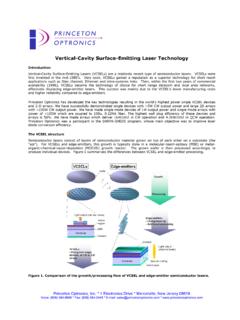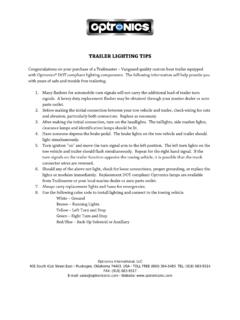Transcription of Application Note - Solid State Optronics
1 2014 Solid State Optronics San Jos , CA + AppNote 020 Rev 02 (09/02 /2014) 002156 Page 1 of 2 Application Note 020 Converting a 1 Form A / 1 Form B Relay into a 1 Form C Relay Introduction A typical 1 Form A / 1 Form B relay consists of a normally open switch and a normally closed switch within a single package. Each relay is controlled by its own separate input LED. A typical Application of a 1 Form A / 1 Form B relay is a situation where a design engineer would like to operate two servo motors, each with its own controlling input signal. The advantages of using a 1 Form A / 1 Form B relay instead of a single 1 Form A relay and a single 1 Form B relay in this case would be cost and space savings.
2 In other applications however, the design engineer might want to operate the two servo motors in unison with a single controlling input signal. In this case, a 1 Form C relay is desired, where a single input controls both outputs. This Application note will demonstrate how to convert a 1 Form A / 1 Form B relay into a 1 Form C relay and how to determine a typical resistor value. These same procedures can be applied to a Dual 1 Form A or B relay in converting them to a 2 Form A or B relay respectively. Description Figure 01 shows Solid State Optronics AD4C113 relay, a 1 Form A / 1 Form B relay with two separate input control circuits. Figure 01: 1 Form A / 1 Form B Connection The Normally Closed (Form B) switch is the upper portion of the relay, while the Normally Open (Form A) switch is the lower portion of the relay.
3 The resistor values (RIN) can be determined by using the following formula: RIN = (VIN - VLED) / ILED (1) Where: RIN is the input resistor VIN is the input control signal source VLED is the forward voltage drop across the LED ILED is the desired forward current through the LED In a standard TTL driven input circuit, the variables will have the following values: VIN = 5V VLED = ILED = 5mA Substituting these values into formula (1), a resistor value of 700 can be calculated. This value does not take into account any temperature fluctuations or tolerance variations but remains a good value to use across a broad range of applications . To convert this relay to a 1 Form C relay, pins 2 & 3 should be connected as shown in Figure 02.
4 Figure 02: 1 Form C Connection Application Note Converting a 1 Form A / 1 Form B Relay into a 1 Form C Relay 123678 Load 2 (NO)Load 1 (NC)Load 1 (NC)45 Load 2 (NO)RINVINRINVINILEDILED123678 Load 2 (NO)Load 1 (NC)Load 1 (NC)45 Load 2 (NO)RINVINILEDILED 2014 Solid State Optronics San Jos , CA + Page 2 of 2 AppNote 020 Rev 02 (09/02 /2014) 002156 Application Note 020 Converting a 1 Form A / 1 Form B Relay into a 1 Form C Relay By connecting pins 2 & 3, one input source can be used to control both switches the Normally Open (NO) and Normally Closed (NC) portions of the relay. However, when both LEDs are connected to the same input driver, a different resistor value must be calculated. In a 1 Form C configuration, there are two LED voltage drops across the input circuitry instead of just one.
5 Formula (1) can be utilized again however a new value of VLED must be used. Instead of , the value will be This new value will generate a resistor value of 400 instead of 700 . Again, the value of 400 does not take into account any temperature or tolerance variations. The main point to consider when connecting pins 2 & 3 is that the input driver circuitry experiences two forward LED voltage drops instead of just one. Break Before Make Functionality Inherent in an electromechanical 1 Form C relay is break before make functionality. The AD4C113 Solid State relay, when wired in the 1 Form C configuration, likewise exhibits the break before make contact properties. Although both LEDs are operated simultaneously via the same input signal, the switching speeds of the Form B and Form A portions of the relay differ.
6 The Turn Off time of the Form B portion is much faster than the Turn On time of the Form A relay. This difference in switching speeds creates the break before make switch characteristics. Higher input control currents can help maximize the effectiveness of break before make functionality. Conclusion The Solid State Optronics 1 Form A / 1 Form B relays can be configured to create a 1 Form C relay by connecting pins 2 & 3. By connecting the two input LEDs in series, a single input can thus be used to switch the Form A and Form B relays. However, when connecting the relay in 1 Form C fashion, two LED forward voltage drops are encountered instead of one.
7 These voltage drops must be considered when designing the input circuitry. Finally, at higher input currents, break before make functionality is inherently exhibited. Visit or contact your local sales agent to learn more.








